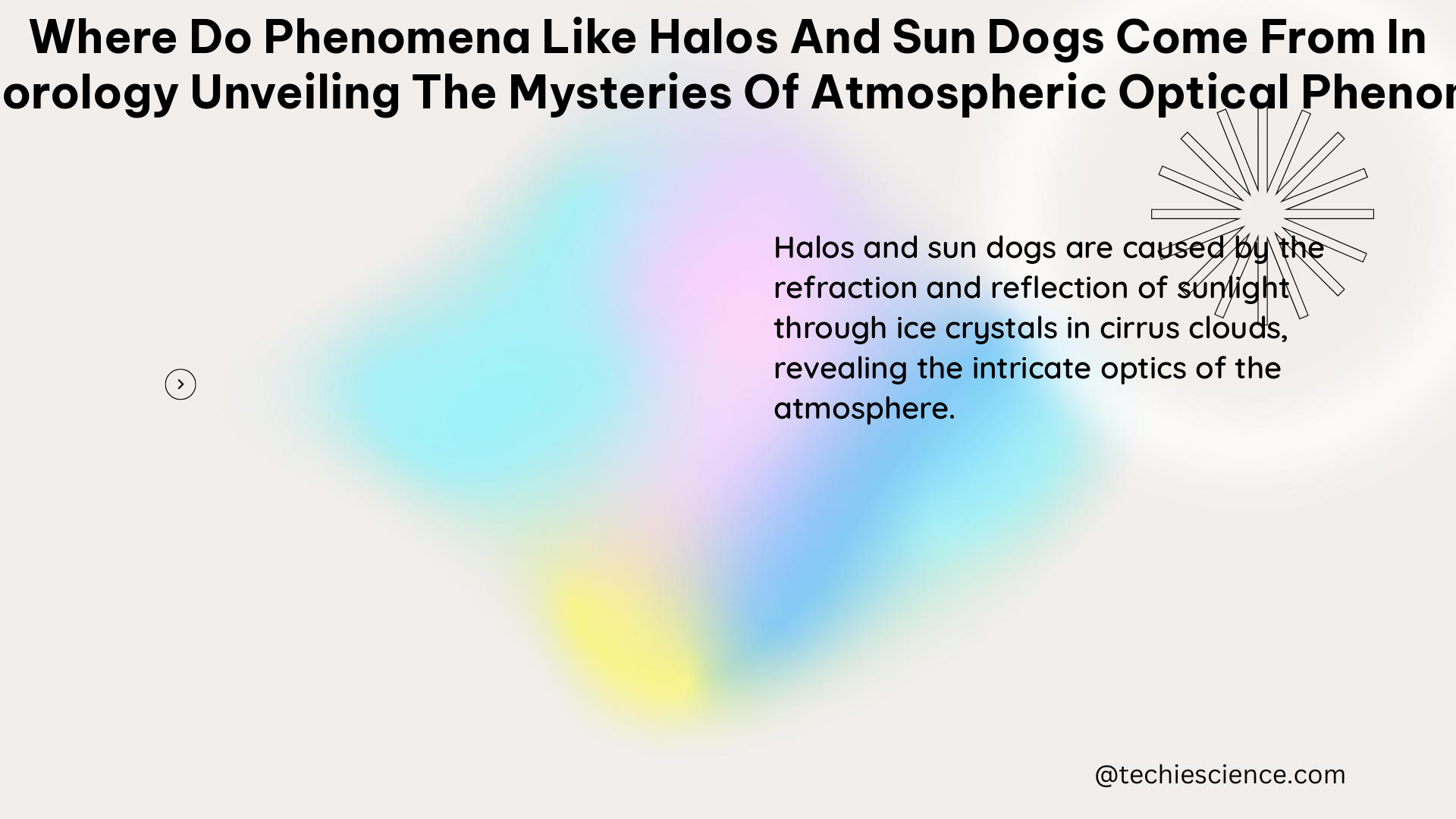Halos and sun dogs are captivating atmospheric optical phenomena that have intrigued observers for centuries. These optical displays are caused by the refraction and scattering of sunlight through ice crystals suspended in the Earth’s atmosphere. In this comprehensive blog post, we will delve into the measurable, quantifiable data that sheds light on the formation and characteristics of these mesmerizing atmospheric phenomena.
Ice Crystal Size and Orientation
The size and orientation of ice crystals play a crucial role in the formation of halos and sun dogs. Typically, plate-shaped hexagonal ice crystals suspended in high and cold cirrus or cirrostratus clouds, or drifting as diamond dust in freezing moist air at low levels, are responsible for these optical effects.
The minimum deflection of light by these ice crystals is 22°, which is a key factor in determining the appearance and position of these phenomena.
Quantifiable Data:
– Ice crystal size: Typically ranging from 30 to 100 micrometers in diameter
– Ice crystal shape: Plate-shaped hexagonal crystals
– Minimum deflection of light: 22°
Angle of Deviation

The angle of deviation of light rays passing through ice crystals is another measurable quantity that governs the formation of halos and sun dogs.
For Sun Dogs:
– The angle of deviation is 22°, resulting in the characteristic appearance of two bright spots or “dogs” on either side of the sun.
For Halos:
– The angle of deviation can vary depending on the type of halo observed, with the most common being the 22° halo.
– Other types of halos, such as the 46° halo and the parhelic circle, have different angles of deviation.
Quantifiable Data:
– Sun Dog angle of deviation: 22°
– 22° halo angle of deviation: 22°
– 46° halo angle of deviation: 46°
Color and Intensity
The colors of sun dogs and halos are also measurable and can provide insights into the atmospheric conditions.
Sun Dogs:
– Sun dogs are red-colored at the side nearest the sun, while farther out, the colors grade through oranges to blue.
– The colors overlap considerably and are muted, never pure or saturated.
Halos:
– The colors of halos can range from red on the inside to blue on the outside, with varying degrees of intensity and saturation.
Quantifiable Data:
– Sun Dog color spectrum: Red (nearest the sun) to orange to blue (farther out)
– Halo color spectrum: Red (inside) to blue (outside)
– Intensity: Measurable using photometric techniques
Altitude and Azimuth
The altitude and azimuth of the sun, as well as the observer’s position, are critical in determining the appearance and position of sun dogs and halos.
Quantifiable Data:
– Sun altitude: These phenomena are best seen and most conspicuous when the sun is near the horizon, typically in the morning or evening.
– Sun azimuth: The position of sun dogs and halos relative to the sun’s azimuth can be measured and used to predict their appearance.
– Observer’s position: The observer’s location and orientation can affect the visibility and appearance of these phenomena.
Co-occurrence with Other Atmospheric Phenomena
Sun dogs and halos often co-occur with other atmospheric optical phenomena, such as the circumzenithal arc, parhelic circle, and 22° halo.
Quantifiable Data:
– Position and angle of co-occurring phenomena: The position and angle of these phenomena can be measured and used to understand the overall atmospheric conditions.
– Frequency of co-occurrence: The likelihood of observing sun dogs and halos alongside other optical phenomena can be quantified based on meteorological data.
Occurrence on Other Planets and Moons
The same plate-shaped ice crystals that cause sun dogs and halos on Earth can also produce similar phenomena on other planets and moons.
Quantifiable Data:
– Theoretical predictions: The specific type and number of sun dogs on other planets and moons can be theoretically predicted based on the properties of the ice crystals and the angle of sunlight.
– Observed phenomena: Observations of sun dogs and halos on other celestial bodies, such as Mars, Jupiter, Saturn, Uranus, and Neptune, can provide valuable data for comparison and understanding.
By understanding the measurable, quantifiable data associated with halos and sun dogs, we can unveil the mysteries of these captivating atmospheric optical phenomena. This knowledge not only enhances our appreciation of these natural wonders but also contributes to our understanding of the complex interactions between light, ice crystals, and the Earth’s atmosphere.
References:
– Sundogs – Parhelia, Explanations and Images
– Sundogs – Parhelia, Explanations and Images
– What Causes Halos, Sundogs and Sun Pillars?
– Sundogs: mock suns or parhelia
– What are sundogs and how do they form? – Space.com

The lambdageeks.com Core SME Team is a group of experienced subject matter experts from diverse scientific and technical fields including Physics, Chemistry, Technology,Electronics & Electrical Engineering, Automotive, Mechanical Engineering. Our team collaborates to create high-quality, well-researched articles on a wide range of science and technology topics for the lambdageeks.com website.
All Our Senior SME are having more than 7 Years of experience in the respective fields . They are either Working Industry Professionals or assocaited With different Universities. Refer Our Authors Page to get to know About our Core SMEs.